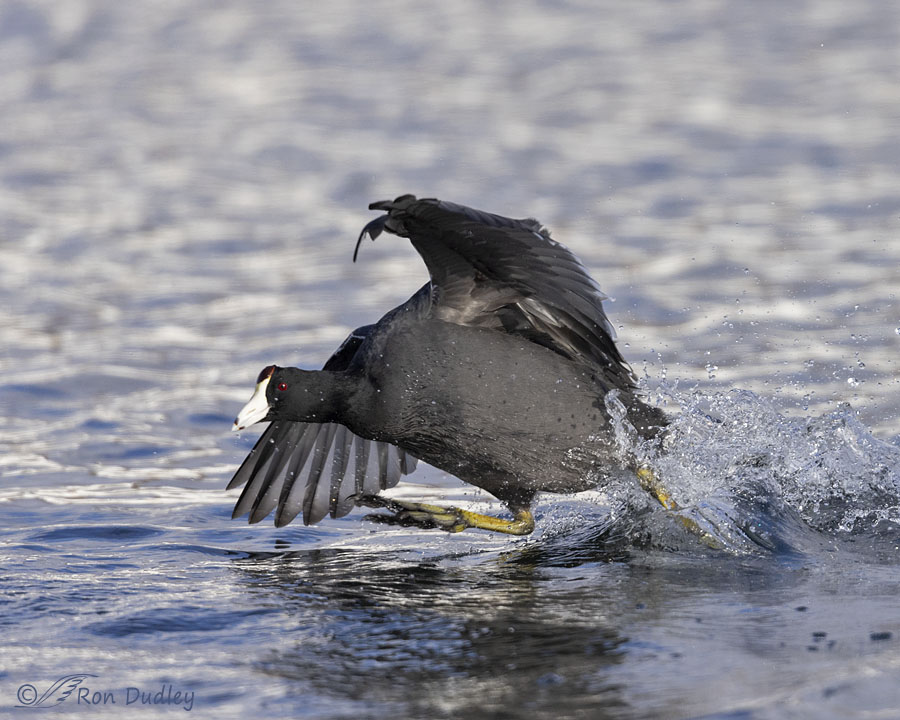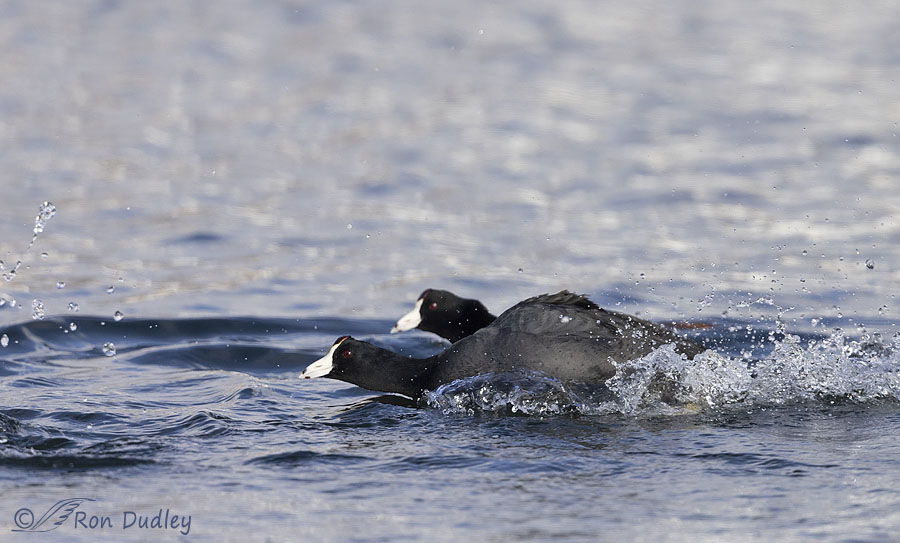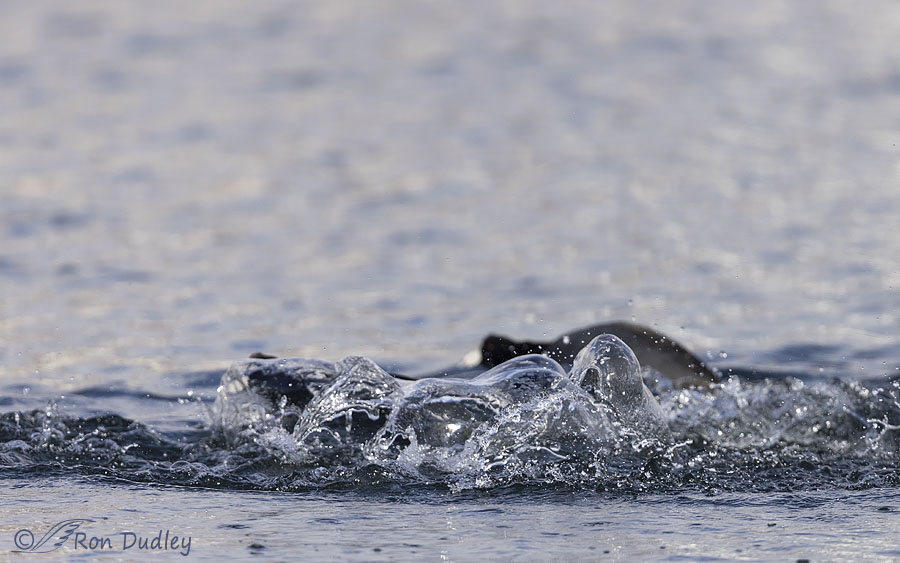American Coots are universally described as quarrelsome and belligerent but this time of year they crank it up a notch. Or two.
In late fall coots begin to show up in large numbers at a pond I frequent but for the first few weeks they’re pretty even-tempered so they can be kind of boring to photograph. But in December, when it begins to snow and patches of the pond begin to ice up, they turn into barroom brawlers.
It’s a transformation I see every year and yesterday afternoon I saw my first evidence of it in many of the coots on the pond.

1/5000, f/5.6, ISO 800, Canon EF500mm f/4L IS II USM + 1.4 tc, not baited, set up or called in
I got quite a few photos of angry coots but I like this one best, in part because of the way ‘his’ body is tipped slightly toward the viewer as he pursued another coot that had apparently invaded his feeding territory. His running feet and the water splashes add to the excitement.
But I’m still trying to figure out his precise motivation for the attack. Was he really defending his feeding territory or was he defending his mate from the other coot?
This time of year, many of the coots on the pond appear to be paired up already. They tend to feed and hang out in pairs and act belligerently toward other coots that come in too close to them. However, Cornell says two things that almost seem to be conflicting:
- there are “no reports of courting or pair formation on wintering grounds”.
- but they also say that the timing of coot pair formation is “disputed” amongst researchers, which to me implies that it’s possible that at least some of them pair up earlier in winter.
Hopefully the following photo, taken in the same burst and almost immediately after the photo above, will help to explain my confusion.

1/5000, f/5.6, ISO 800, Canon EF500mm f/4L IS II USM + 1.4 tc, not baited, set up or called in
Here the presumed male in the first photo is beginning to settle back down into the water after chasing away the other coot, whose water splash as it escapes can be seen at the left edge of the frame. I had presumed that the coot behind the male was his mate because I watched them feeding peacefully and very close to each other for quite a while. When the third coot got a little too close to his presumed mate, the first male took major exception and attacked.
But if they don’t form pair bonds this early, I must be wrong about them being a mated pair. So maybe he attacked the other male? because that bird invaded his feeding territory, which is extremely common behavior for coots.
But if that’s the case, why was the original male so accepting of the presumed female in his feeding territory? After this series was taken, those two birds went calmly back to feeding very close to each other.
No biggie but I wonder about things like that.
Ron
Note: I’m adding another photo in the series as an afterthought.

1/5000, f/5.6, ISO 800, Canon EF500mm f/4L IS II USM + 1.4 tc, not baited, set up or called in
Here the male is putting on the brakes after chasing the other coot away, which caused him to sink down in the water and the backwash from his pursuit to wash over his back As a result, we can barely see him (his white bill allows us to place him in the frame) but I’m entertained by the turbulent water flowing over his back. And amused by the indifference of the presumed female to his efforts as she turns away from him. Apparently she isn’t easily impressed.


Great photos! The toes on these coots are fascinating. They are uncommon here in my part of Virginia but they are sometimes seen in the winter. I think I might keep an eye out for sightings so I can see one for myself.
Thank you, Liz.
A very exciting post today! They are odd-looking birds. Their red eyes somehow increase the intensity of their stare, and those straight, lowered necks – wow, I’d definitely take that as a “back-off” signal if I was on that pond! And Lyle’s poem dramatically covers all the bases for what might be going on. Science, Art, Literature, all before 10AM. What a good day!

“Science, Art, Literature, all before 10AM. What a good day!”
Loved that, Carolyn.
Where did their name, coot, come from? I can see it derived from the Latin for coot, Fulica. Great series, you will have to look closely at some of your wing shots from time to time, they have a claw on what would be their equivalent of a thumb. It’s a good size, easy to see when the bird is in hand.
“they have a claw on what would be the equivalent of a thumb”
April, they must share that trait with the Hoatzin.
https://www.insidescience.org/news/baby-birds-use-wing-claws-climb-through-amazon
And I don’t know here the name “coot” came from.
Always love seeing American Coots! I like these shots as much for the water action as the bird action. Such interesting properties packed into a tiny molecule!
I definitely need to get back to my walking route that crosses the channel behind our neighborhood so I can catch up with the local coots and their antics. Once my foster pupper goes back to the spca, for sure — we’ve got another week or two.
“I like these shots as much for the water action as the bird action”
In that regard, and more than a few others, you and I are two of a kind, Marty.
“In that regard, and more than a few others, you and I are two of a kind, Marty.”
I consider this a great compliment.
I’m thinking they were paired-up; be they mated or BFFs.
Yet another wonderful series. And my grumpy self is loving the disinterest of the presumed female this morning.
Thanks, EC. She was more interested in going back to feeding than she was in the feisty antics of the other two coots.
Who You Callin’ a Coot?
What cause has a Coot
for such angry pursuit?
Food-territorial,
or a tad more romantical?
What else could it be,
what motive is left.
Perhaps its because
they’re just BFF’s.
“Perhaps its because
they’re just BFF’s”
Another Lyle smile. I suppose that’s possible too.
Brilliant!
Thanks, Ron, for highlighting this bird that is sometimes affectionately referred to as an ivory billed duck as “coot” is considered derogatory in a gathering of retired senior bird watchers! The Oregon Chapter of the American Old Coot Society met last night to share the latest in their birding adventures. For the record there is no other chapter, and the term Society a misnomer. But many of us follow your postings with great interest and joy!
Thanks again.
“many of us follow your postings with great interest and joy”
I’m delighted to know that, Jim. And I love the sense of humor of your “society”.
I love the look of the water in the last shot. Sounds and looks like a relaxing day in the field— I can just feel that crisp, cold Utah air now! Thanks for posing, coots. And thanks Ron for capturing the moment. I really enjoyed these photos!
Teri, our “crisp, cold Utah air” was 10° earlier this morning and it’s supposed to stay unusually cold for the next few days. I imagine the pond is about to be frozen over for a good long while.
Ron,
Hence the phrase: “Angry old coot?”
Stephen
Yup.
Coot feet remind me of lily pads. As for early mating/pairing behavior I agree with you, Ron. I have no personal knowledge of pair bonding in Coots however the aggressive behavior toward the third bird makes the theory logical and plausible. I love these photos. The action in the first pic, the synchronized swimming in the second and the amazing dancing water in the third presents a wonderful series.
“Coot feet remind me of lily pads”
I see what you mean, Melanie. Thanks.
Love those coot photos! Especially the first one – great shot!!
Glad you like them, Joanne. Thanks.
When I read the title of this post in my email, for a second I wondered if you were posting selfies today!
Sue, I’m not a selfie kinda guy. Besides, if that had been the case my title would have been “An Angry Old Coot”.
Yeah, yeah, you’re old for sure, but you’re also American, you old coot!
Fun series and a continuing mystery it seems…….. Luv the 1st photo – it really captures the intensity of the chase!
Luv the 1st photo – it really captures the intensity of the chase!
Still just 1 grey crowned rosy finch but have a flock of what I believe are tree sparrows – used the tube feeder and have a yellow lower beak. She shade/spooky nature/chain link of the kennel where the feed is makes it tough to look closely.
Thanks, Judy. Neat to have that many tree sparrows. I don’t see them often.
Haven’t had them like this before……..sparrows we usually get are fewer in number and don’t use the tube feeder…….
Good morning Ron. Have seen this behavior many times, but never photographed it. Excellent shots all, but of course like the first one best.
Love those huge feet. Once in a while when they are standing around I have taken photos of those big feet. Sure makes running across water a lot easier.
Thanks, Everett. Their feet are amazing. And bizarre.